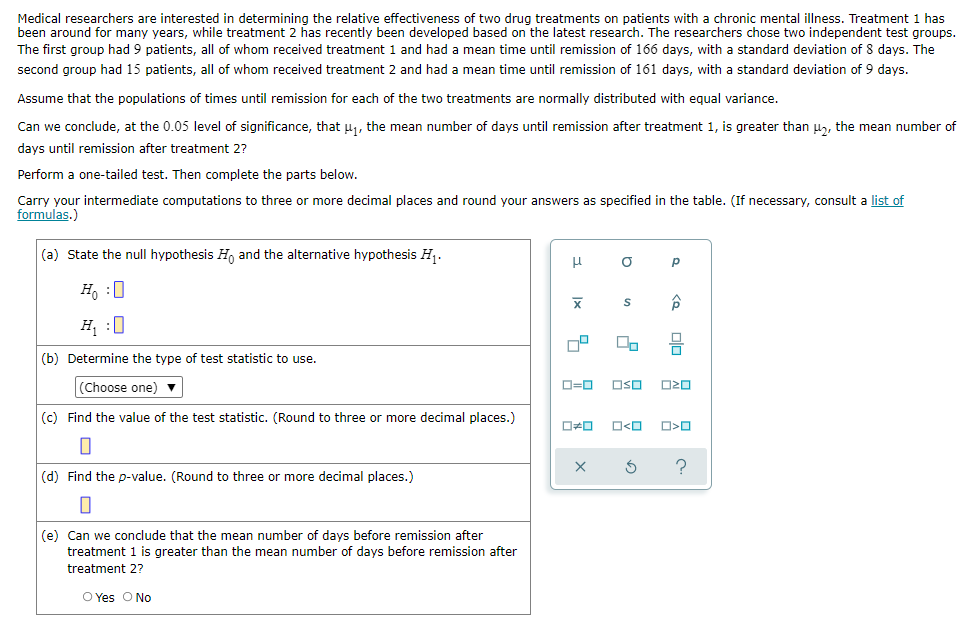Medical researchers are interested in determining the relative effectiveness of two drug treatments on patients with a chronic mental illness. Treatment 1 has been around for many years, while treatment 2 has recently been developed based on the latest research. The researchers chose two independent test groups. The first group had 9 patients, all of whom received treatment 1 and had a mean time until remission of 166 days, with a standard deviation of 8 days. The second group had 15 patients, all of whom received treatment 2 and had a mean time until remission of 161 days, with a standard deviation of 9 days. Assume that the populations of times until remission for each of the two treatments are normally distributed with equal variance. Can we conclude, at the 0.05 level of significance, that u, the mean number of days until remission after treatment 1, is greater than u, the mean number of days until remission after treatment 2? Perform a one-tailed test. Then complete the parts below. Carry your intermediate computations to three or more decimal places and round your answers as specified in the table. (If necessary, consult a list of formulas.) (a) State the null hypothesis H, and the alternative hypothesis H1. Ho :0 H :0 (b) Determine the type of test statistic to use. (Choose one) O=0 OSO (c) Find the value of the test statistic. (Round to three or more decimal places.) O
Medical researchers are interested in determining the relative effectiveness of two drug treatments on patients with a chronic mental illness. Treatment 1 has been around for many years, while treatment 2 has recently been developed based on the latest research. The researchers chose two independent test groups. The first group had 9 patients, all of whom received treatment 1 and had a mean time until remission of 166 days, with a standard deviation of 8 days. The second group had 15 patients, all of whom received treatment 2 and had a mean time until remission of 161 days, with a standard deviation of 9 days. Assume that the populations of times until remission for each of the two treatments are normally distributed with equal variance. Can we conclude, at the 0.05 level of significance, that u, the mean number of days until remission after treatment 1, is greater than u, the mean number of days until remission after treatment 2? Perform a one-tailed test. Then complete the parts below. Carry your intermediate computations to three or more decimal places and round your answers as specified in the table. (If necessary, consult a list of formulas.) (a) State the null hypothesis H, and the alternative hypothesis H1. Ho :0 H :0 (b) Determine the type of test statistic to use. (Choose one) O=0 OSO (c) Find the value of the test statistic. (Round to three or more decimal places.) O
MATLAB: An Introduction with Applications
6th Edition
ISBN:9781119256830
Author:Amos Gilat
Publisher:Amos Gilat
Chapter1: Starting With Matlab
Section: Chapter Questions
Problem 1P
Related questions
Question

Transcribed Image Text:Medical researchers are interested in determining the relative effectiveness of two drug treatments on patients with a chronic mental illness. Treatment 1 has
been around for many years, while treatment 2 has recently been developed based on the latest research. The researchers chose two independent test groups.
The first group had 9 patients, all of whom received treatment
and had a mean time until remission of 166 days, with a standard deviation of 8 days. The
second group had 15 patients, all of whom received treatment 2 and had a mean time until remission of 161 days, with a standard deviation of 9 days.
Assume that the populations of times until remission for each of the two treatments are normally distributed with equal variance.
Can we conclude, at the 0.05 level of significance, that u, the mean number of days until remission after treatment 1, is greater than u,, the mean number of
days until remission after treatment 2?
Perform a one-tailed test. Then complete the parts below.
Carry your intermediate computations to three or more decimal places and round your answers as specified in the table. (If necessary, consult a list of
formulas.)
(a) State the null hypothesis H, and the alternative hypothesis H .
Ho :0
H :0
(b) Determine the type of test statistic to use.
(Choose one) ▼
O=0
OSO
(c) Find the value of the test statistic. (Round to three or more decimal places.)
O<O
(d) Find the p-value. (Round to three or more decimal places.)
(e) Can we conclude that the mean number of days before remission after
treatment 1 is greater than the mean number of days before remission after
treatment 2?
O Yes O No
<8 olo
Expert Solution
This question has been solved!
Explore an expertly crafted, step-by-step solution for a thorough understanding of key concepts.
Step by step
Solved in 3 steps with 3 images

Recommended textbooks for you

MATLAB: An Introduction with Applications
Statistics
ISBN:
9781119256830
Author:
Amos Gilat
Publisher:
John Wiley & Sons Inc

Probability and Statistics for Engineering and th…
Statistics
ISBN:
9781305251809
Author:
Jay L. Devore
Publisher:
Cengage Learning

Statistics for The Behavioral Sciences (MindTap C…
Statistics
ISBN:
9781305504912
Author:
Frederick J Gravetter, Larry B. Wallnau
Publisher:
Cengage Learning

MATLAB: An Introduction with Applications
Statistics
ISBN:
9781119256830
Author:
Amos Gilat
Publisher:
John Wiley & Sons Inc

Probability and Statistics for Engineering and th…
Statistics
ISBN:
9781305251809
Author:
Jay L. Devore
Publisher:
Cengage Learning

Statistics for The Behavioral Sciences (MindTap C…
Statistics
ISBN:
9781305504912
Author:
Frederick J Gravetter, Larry B. Wallnau
Publisher:
Cengage Learning

Elementary Statistics: Picturing the World (7th E…
Statistics
ISBN:
9780134683416
Author:
Ron Larson, Betsy Farber
Publisher:
PEARSON

The Basic Practice of Statistics
Statistics
ISBN:
9781319042578
Author:
David S. Moore, William I. Notz, Michael A. Fligner
Publisher:
W. H. Freeman

Introduction to the Practice of Statistics
Statistics
ISBN:
9781319013387
Author:
David S. Moore, George P. McCabe, Bruce A. Craig
Publisher:
W. H. Freeman